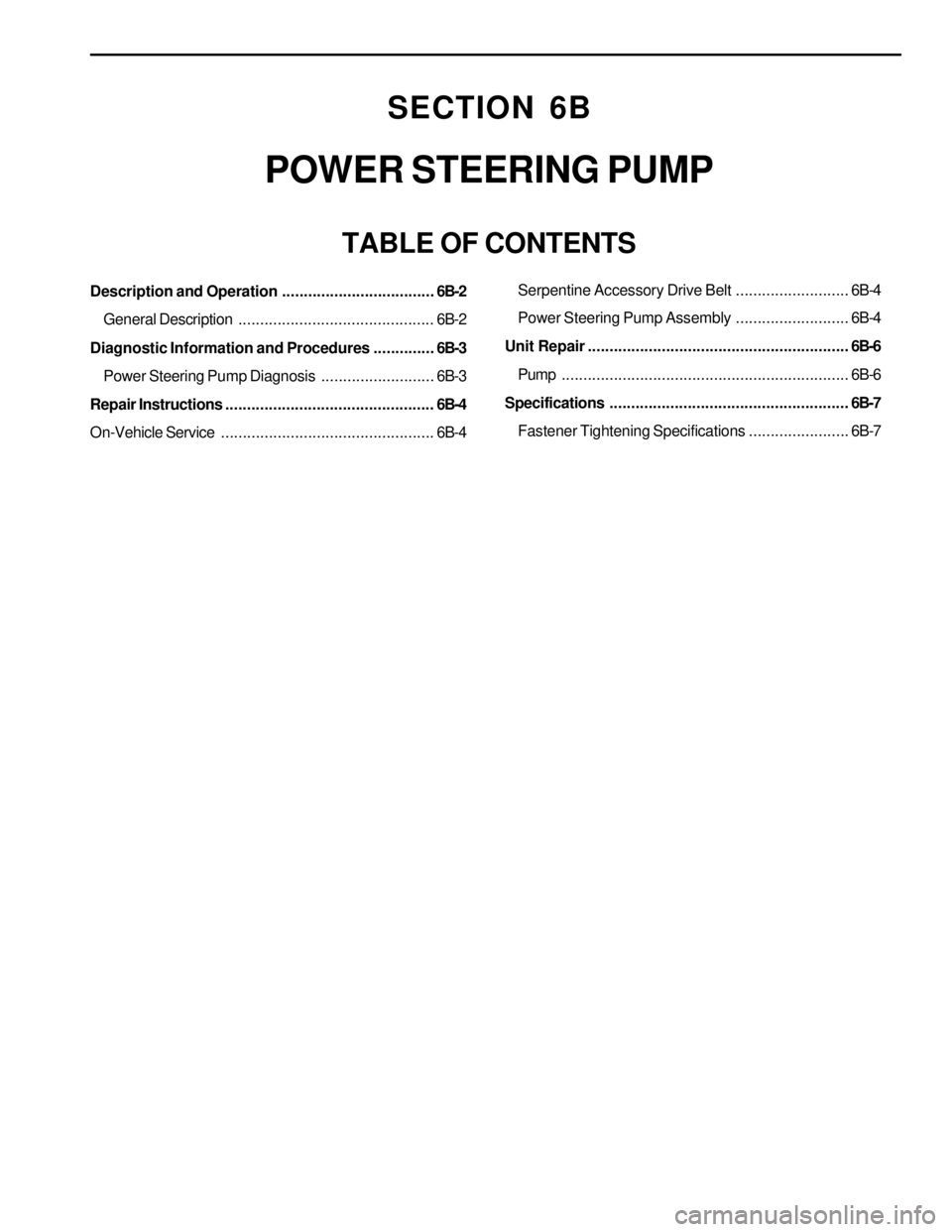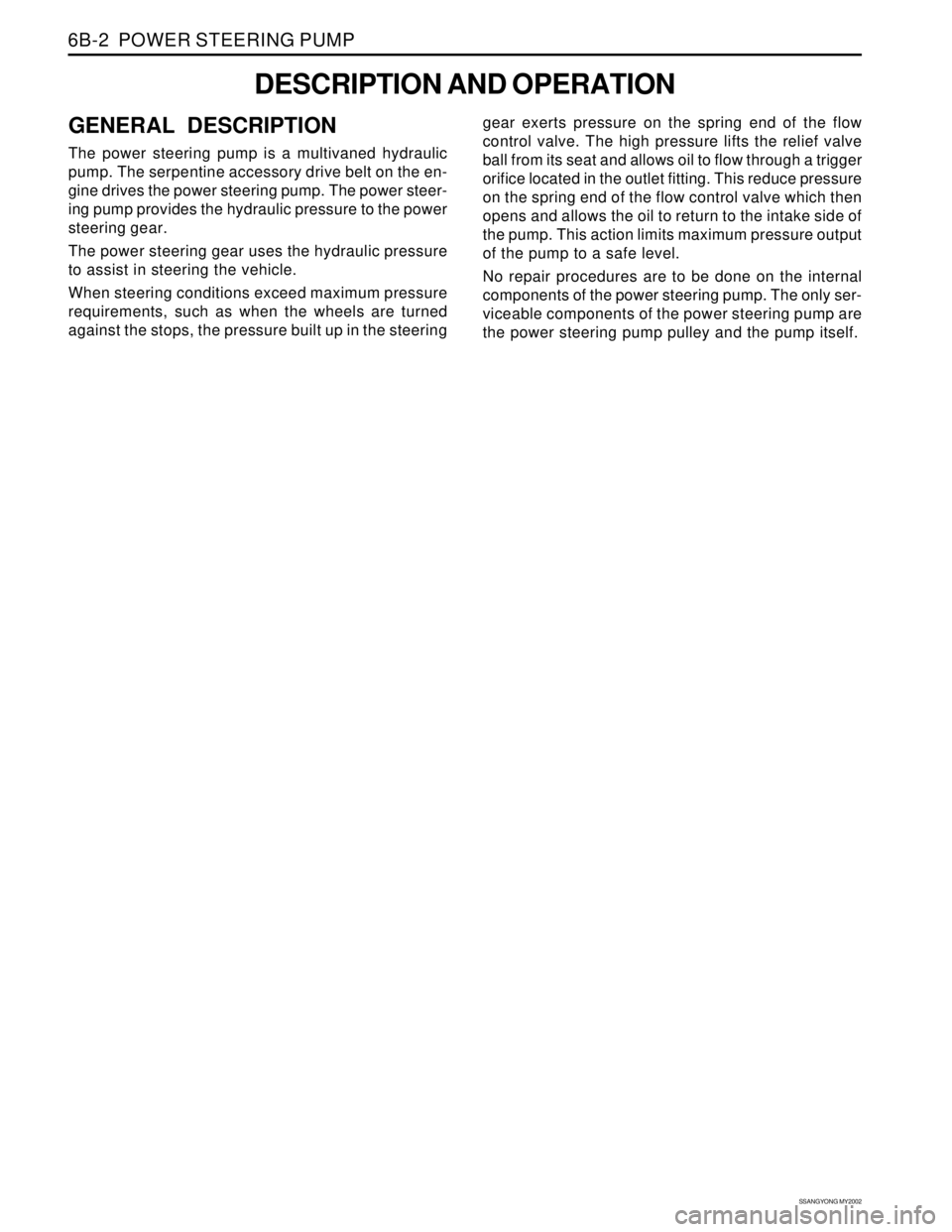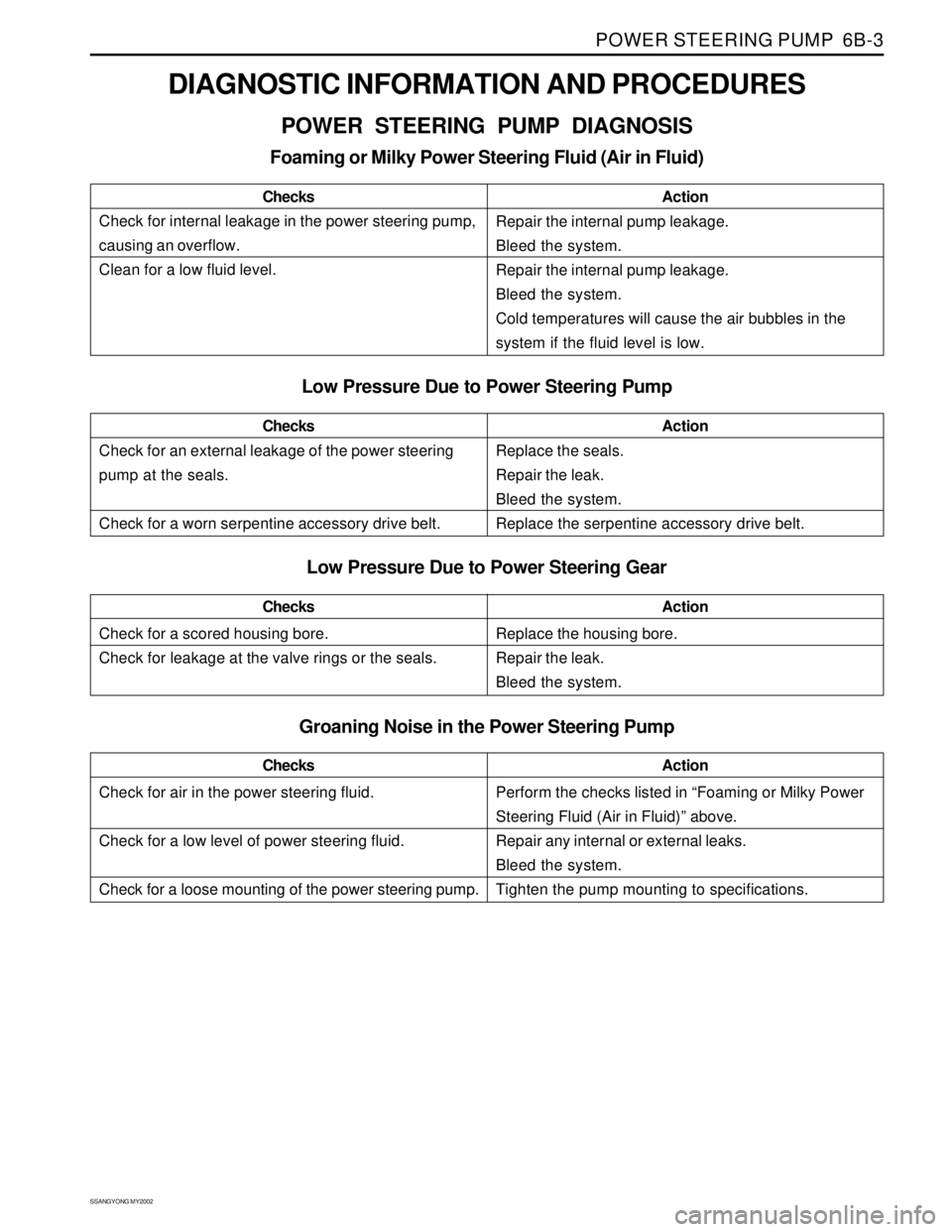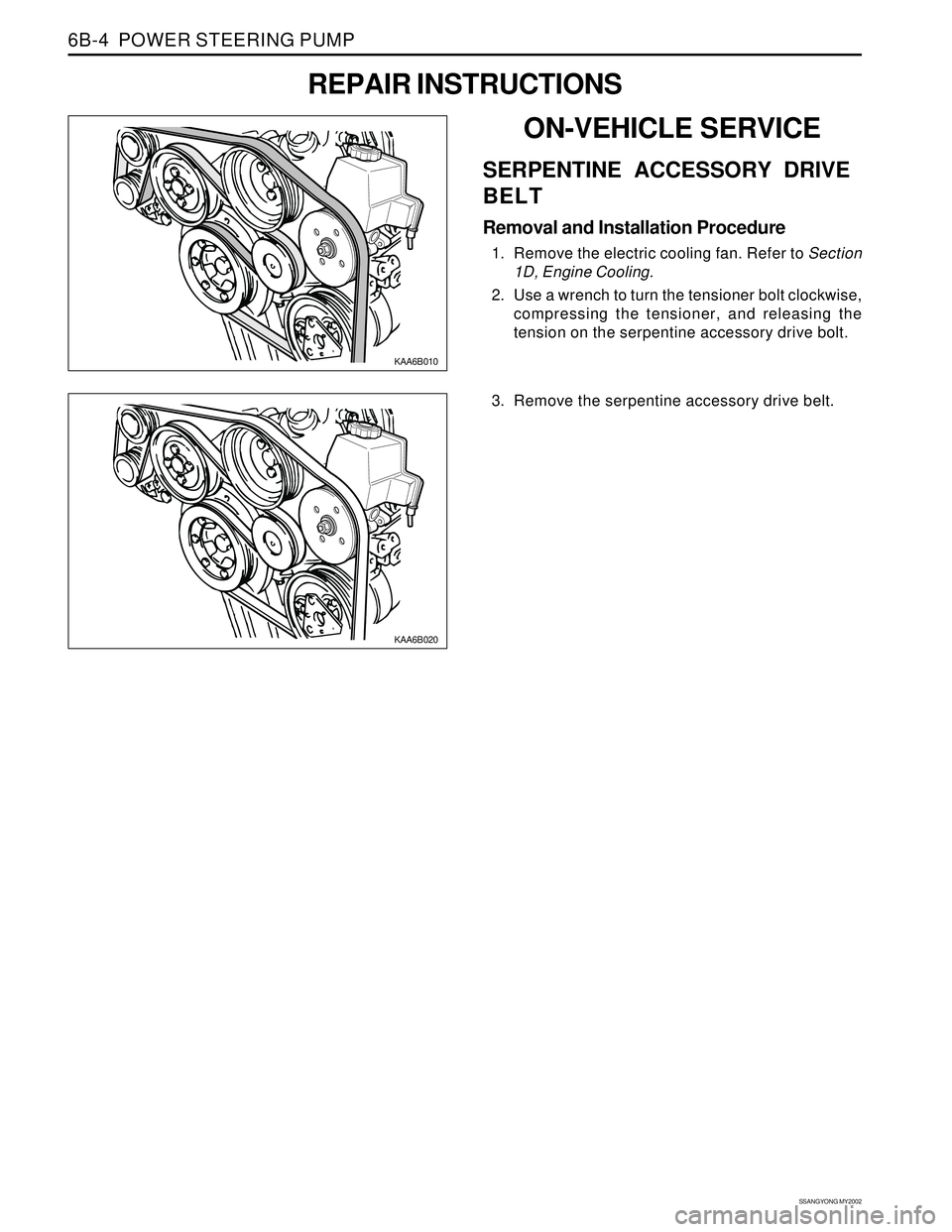1997 SSANGYONG KORANDO belt
[x] Cancel search: beltPage 818 of 2053

SSANGYONG MY2002
2A-6 SUSPENSION DIAGNOSIS
Check the front-wheel and the rear-wheel alignment.
Inspect for worn dampeners.
Inspect for worn or loose wheel bearings.
Inspect for excessive tire or wheel runout.
Inspect for a worn ball joint.
Check the steering gear preload adjustment.Align the front and the rear wheels.
Replace the dampeners.
Replace the wheel bearings.
Match-mount the tires. Replace the tires, as needed.
Replace the wheels, as needed.
Replace the ball joint.
Perform a rack bearing preload adjustment.Action ChecksReplace the seals and the hoses, as needed.
Clean the pinion valve assembly. Replace the pinion
valve assembly, as needed.
Adjust the power steering pump serpentine belt. Check the hydraulic system. Test the power steering
system pressure with a gauge.
Inspect for a sluggish steering gear valve.
Inspect for a loose power steering pump serpentine
belt.Action ChecksAction Checks
Purge the power steering system of air.
Tighten the steering gear mounting bracket nuts and
the bolts.
Tighten the intermediate shaft pinch bolts. Replace the
intermediate shaft, as needed.
Tighten the tie rod ends. Replace the outer tie rods, as
needed.
Replace the front wheel bearings. Inspect for air in the power steering system.
Inspect for a loose steering gear mounting.
Inspect the joint from the column to the steering gear
for loose connections or wear.
Inspect for loose tie rod ends.
Inspect for loose or worn front wheel bearings.
Steering Wheel Surges or Jerks
Cupped Tires
Steering Wheel Kickback
Page 822 of 2053

WHEEL ALIGNMENT 2B-3
SSANGYONG MY2002
DIAGNOSTIC INFORMATION AND PROCEDURES
TIRE DIAGNOSIS
Irregular and Premature Wear
Irregular and premature tire wear has many causes.
Some of them are incorrect inflation pressures, lack of
regular rotation, poor driving habits, or improper wheel
alignment.
Rotate the tires if :
•The front tire wear is different from the rear.
The left and right front tire wear is unequal.
The left and right rear tire wear is unequal.
Check wheel alignment if :
The left and right front tire wear is unequal.
The wear is uneven across the tread of either front
tire.
The front tire treads are scuffed with “feather” edges
on the side of the tread ribs or blocks.
Tread Wear Indicators
The original equipment tires have built-in tread wear in
dicators to show when the tires need replacement.
These indicators appear as bands when the tire tread
depth becomes shallow. Tire replacement is recom
mended when the indicators appear in three or more
grooves at six locations.
KAA2B010
Radial Tire Waddle
Waddle is side-to-side movement at the front or rear of
the vehicle. It is caused by the steel belt not being
straight within the tire, or by excessive lateral runout
of the tire or wheel.
The vehicle must be road tested to determine which
end of the vehicle has the faulty tire. The rear end of
the vehicle will shake from side to side or “waddle” if
the waddle tire is on the rear of the vehicle. From the
driver’s seat, it feels as though someone is pushing
on the side of the vehicle.
If the faulty tire is on the front of the vehicle, the waddle
is more visual. The front sheet meld appears to be mov-
ing back and forth, and the drivers seat feels like the
pivot point in the vehicle.
Waddle can be diagnosed using the method of substitut-
ing known good tire and wheel assemblies on the prob-
lem vehicle.
1. Road test the vehicle to determine if the waddle is
coming from the front or the rear of the vehicle.
2. Install good tires and wheels from a similar vehicle
in place of those on the offending end of the problem
vehicle. If the source of the waddle is not obvious,
change the rear tires.
3. Road test the vehicle. If there is improvement,
install the original tires to find the offending tire. If
there is no a straight improvement, install good tires
in place of all four offending tires.
KAA2B020
Page 823 of 2053

SSANGYONG MY2002
2B-4 WHEEL ALIGNMENT
KAA2B030
RADIAL TIRE LEAD/PULL
Lead/pull is the deviation of the vehicle from a straight
path on a level road with no pressure on the steering
wheel. Lead is usually caused by:
Incorrect alignment.
Uneven brake adjustment.
Tire construction.
The way in which a tire is built can produce lead/pull in
the vehicle. Off-center belts on radial tires can cause
the tire to develop a side force while the vehicle rolls
straight down the road. If one side of the tire has even
a little larger diameter than the diameter of the other
side, the tire will tend to roll to one side. Unequal
diameters will cause the tire to develop a side force
which can produce vehicle lead/pull.
The radial lead/pull diagnosis chart should be used to
determine whether the problem originates from an align-
ment problem or from the tires. Part of the lead diagno-
sis procedure calls for tire rotation that is different from
the proper tire rotation pattern. If a medium-to high-
mileage tire is moved to the other side of the vehicle,
be sure to check for ride roughness. Rear tires will not
cause lead/pull.
Page 857 of 2053

TIRE AND WHEELS 2E-3
SSANGYONG MY2002
TIRE CHAIN USAGE
Due to limited tire-to-body clearance on certain
vehicles, recommendations for tire chain use are
published in the Owner’s Manual. When tire chains
need to be used, most current Ssangyong vehicles
require SAE Class “S” tire chains. These may also be
designated as 1100 Series, type PL tire chains. These
chains are specifically designed to limit the “fly off”
effect which occurs when the wheel rotates.
Be sure that only fine-link chains are used which do
not add more than 15 mm (0.590 inch), including the
lock, to the tread surface and the inner sides of the
tires. Manufacturers of tire chains have a specific chain
size for each tire size to ensure a proper fit when the chain
is installed. Be sure to purchase the correct chains for the
tires on which they are to be used. Use rubber adjusters to
take up any slack or clearance in loose chains.
Use of chains may adversely affect vehicle handling.
When tire chains are installed, follow these precautions:
Adjust speed to road conditions.
Avoid sharp turns.
Avoid locked-wheel braking.
To prevent chain damage to the vehicle, install the
chains on the front tires as tightly as possible. Tighten
them again after driving 0.4 to 0.8 kilometer (0.3 to 0.5
mile). The use of chains on the rear tires is not recom-
mended because they may contact the vehicle and pos-
sibly damage it. If chains must be used on the rear
tires, be sure there is sufficient clearance between the
chains and the body. Do not exceed 70 km/h (45 mph)
or the chain manufacturer’s speed limit, if lower. Avoid
large bumps, potholes, severe turns and any other
maneuvers which could cause the tires to bounce.
Follow any other instructions of the chain manufacturer
which do not disagree with the above instructions.
REPLACEMENT TIRES
A tire performance criteria (TPC) specification number
is molded in the sidewall near the tire size of all original
equipment tires. This specification number assures that
the tire meets performance standards for traction, en
durance, dimensions, noise, handling and rolling
resistance. Usually a specific TPC number is assigned
to each tire size.
Caution: Do not mix different types of tires on the
same vehicle such as radial, bias and bias-belted
tires except in emergencies, because vehicle han-
dling may be seriously affected and may result in
loss of control.Use only replacement tires with the same size, load
range, and construction as the original. The use of any
other tire size or construction type may seriously affect
ride, handling, speedometer/odometer calibration, ve-
hicle ground clearance, and tire clearance to the body
and the chassis. This does not apply to the spare tire
furnished with the vehicle.
It is recommended that new tires be installed in pairs
on the same axle.
If it is necessary to replace only one tire, pair it with the
tire having the most tread to equalize the braking action.
Although they may appear different in tread design, tires
built by different manufacturers with identical TPC speci-
fications may be used on the same vehicle.
ALL SEASON TIRES
Most vehicles are now equipped with steel-belted all
season radial tires as standard equipment. These tires
qualify as snow tires, with a 37 percent higher average
rating for snow traction than the non-all season radial
tires previously used. Other performance areas, such
as wet traction, rolling resistance, tread life, and air
retention, have also been improved. This was done by
improvements in both tread design and tread
compounds. These tires are identified by an “M + S”
molded in the tire sidewall following the size number.
The suffix “MS” is also molded in the sidewall after
the TPC specification number.
The optional handling tires used on some vehicles are
not all season tires. These will not have the “MS” mark-
ing after the tire size or the TPC specification number.
PASSENGER METRIC SIZED TIRES
All Daewoo vehicles now use passenger (P) metric sized
tires. P-metric tires are available in two load ranges:
standard load (35 psi maximum) and extra load (41 psi
maximum). Most passenger vehicle tires are standard
load.
Most P-metric tire sizes do not have exact correspond-
ing alphanumeric tire sizes. For example, a P175/70R13
is not exactly equal in size and load-carrying capacity
to an FR70-13. For this reason, replacement tires should
be of the same TPC specification number as the origi-
nals. If P-metric tires must be replaced with other sizes,
consult a tire dealer. Tire companies can best recom-
mend the closest match of alphanumeric to P-metric
sizes within their own tire lines.
The metric term for measuring tire inflation pressure is
the kilopascal (kPa). Tire pressure may be printed in
both kPa and psi. One psi equals 6.895 kPa.
See the tire label or refer to “Tire Size and Pressure
Specifications” in this section for tire inflation
pressures.
Page 1462 of 2053

SECTION 6B
POWER STEERING PUMP
TABLE OF CONTENTS
Description and Operation...................................6B-2
General Description.............................................6B-2
Diagnostic Information and Procedures..............6B-3
Power Steering Pump Diagnosis..........................6B-3
Repair Instructions................................................6B-4
On-Vehicle Service.................................................6B-4Serpentine Accessory Drive Belt..........................6B-4
Power Steering Pump Assembly..........................6B-4
Unit Repair............................................................6B-6
Pump..................................................................6B-6
Specifications.......................................................6B-7
Fastener Tightening Specifications.......................6B-7
Page 1463 of 2053

SSANGYONG MY2002
6B-2 POWER STEERING PUMP
DESCRIPTION AND OPERATION
GENERAL DESCRIPTION
The power steering pump is a multivaned hydraulic
pump. The serpentine accessory drive belt on the en-
gine drives the power steering pump. The power steer-
ing pump provides the hydraulic pressure to the power
steering gear.
The power steering gear uses the hydraulic pressure
to assist in steering the vehicle.
When steering conditions exceed maximum pressure
requirements, such as when the wheels are turned
against the stops, the pressure built up in the steeringgear exerts pressure on the spring end of the flow
control valve. The high pressure lifts the relief valve
ball from its seat and allows oil to flow through a trigger
orifice located in the outlet fitting. This reduce pressure
on the spring end of the flow control valve which then
opens and allows the oil to return to the intake side of
the pump. This action limits maximum pressure output
of the pump to a safe level.
No repair procedures are to be done on the internal
components of the power steering pump. The only ser-
viceable components of the power steering pump are
the power steering pump pulley and the pump itself.
Page 1464 of 2053

POWER STEERING PUMP 6B-3
SSANGYONG MY2002
DIAGNOSTIC INFORMATION AND PROCEDURES
POWER STEERING PUMP DIAGNOSIS
Foaming or Milky Power Steering Fluid (Air in Fluid)
Low Pressure Due to Power Steering Pump
Check for a scored housing bore.
Check for leakage at the valve rings or the seals.ChecksActionReplace the housing bore.
Repair the leak.
Bleed the system.
Low Pressure Due to Power Steering Gear
Check for internal leakage in the power steering pump,
causing an overflow.
Clean for a low fluid level.ChecksActionRepair the internal pump leakage.
Bleed the system.
Repair the internal pump leakage.
Bleed the system.
Cold temperatures will cause the air bubbles in the
system if the fluid level is low.
Check for an external leakage of the power steering
pump at the seals.
Check for a worn serpentine accessory drive belt.ChecksActionReplace the seals.
Repair the leak.
Bleed the system.
Replace the serpentine accessory drive belt.
Check for air in the power steering fluid.
Check for a low level of power steering fluid.
Check for a loose mounting of the power steering pump.ChecksActionPerform the checks listed in “Foaming or Milky Power
Steering Fluid (Air in Fluid)” above.
Repair any internal or external leaks.
Bleed the system.
Tighten the pump mounting to specifications.
Groaning Noise in the Power Steering Pump
Page 1465 of 2053

SSANGYONG MY2002
6B-4 POWER STEERING PUMP
KAA6B010
REPAIR INSTRUCTIONS
ON-VEHICLE SERVICE
SERPENTINE ACCESSORY DRIVE
BELT
Removal and Installation Procedure
1. Remove the electric cooling fan. Refer to Section
1D, Engine Cooling.
2. Use a wrench to turn the tensioner bolt clockwise,
compressing the tensioner, and releasing the
tension on the serpentine accessory drive bolt.
KAA6B020
3. Remove the serpentine accessory drive belt.